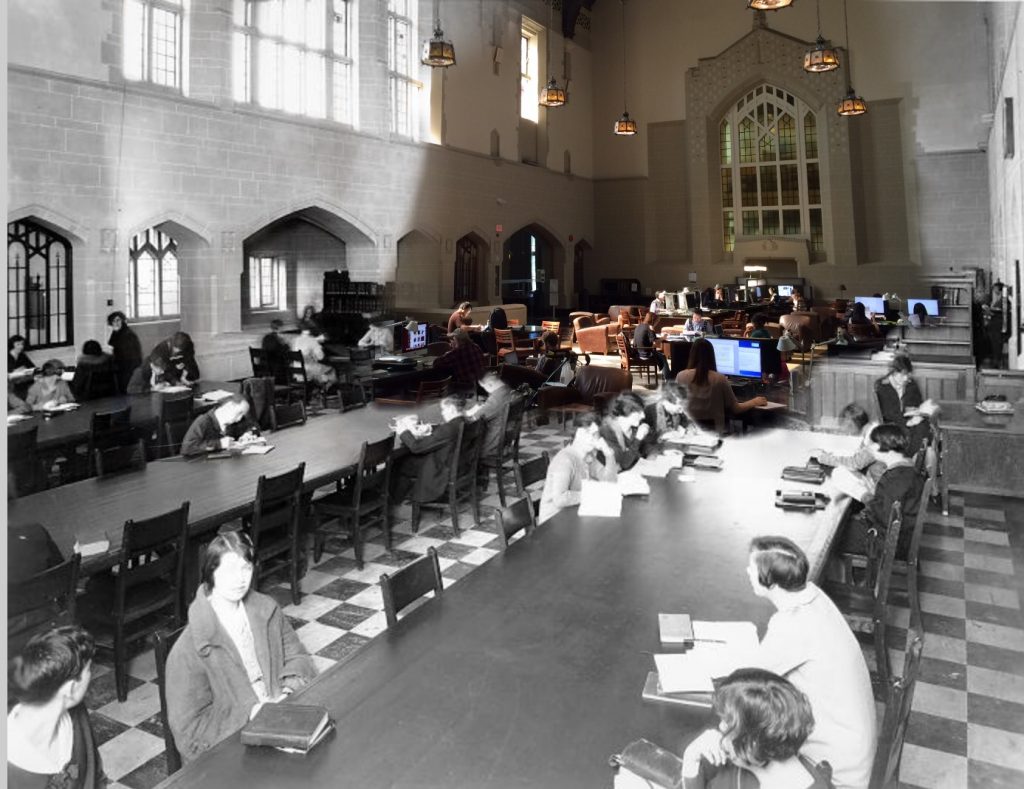Campus Rephotography Tutorial
Students at the UBC Main Library, 1925/2016 (composite by A. S. Metcalfe)
Composite rephotographs (How I made the image above)
Overview: Rephotography (also known as repeat photography) involves taking photos at a specific site over time to show evidence of change (such as “then and now” image pairs). Rephotography requires the selection of a “Time 1” (T1) image, the determination of the exact site and vantage point from which T1 image was taken, forming the basis for subsequent photography from the same position but at a different time, or over several points in time (“Time 2” [T2], “Time 3” [T3], etc.).
Rephotography developed in the natural sciences to demonstrate environmental change, such as erosion or receding glaciers, and has been applied to fields such as sociology to show social change, usually in the built environment (e.g., towns and cities). Rephotography can also be applied to the campus or school setting as a way to discuss organizational change and other aspects relating to the changing environments of educational institutions. Please see the reference list below for methodological literature focusing on rephotography.
Materials: Rephotography can be simple or very technical, depending on the objective. For classroom use, students can use basic digital cameras or camera phones. Composite photographs or collages can be created using free or inexpensive smart phone apps (such as Union). Digitized photographs suitable as T1 images might be found in online archives. Instructors will likely want to pre-select some historical images as demonstrations and identify primary documents and source materials to help set the context. Campus maps from various years are very useful to help identify place names and buildings that may have changed over time.
Recommended steps for rephotography in the classroom (spanning several class sessions, with some steps assigned as out-of-class homework, as appropriate):
- Theoretical discussion or mini lecture (e.g., organizational change, environmental change, institutional history, etc.)
- Introduction to rephotography, including examples
- Overview of techniques and materials needed
- Discussion of the research/learning objective: what is the aim of the comparison?
- Identify contextualizing, historical materials (campus newspaper articles, annual reports, yearbooks, etc.)
- Select historical T1 images that relate to the research objective. (Depending on the amount of time available for this activity, instructors might offer pre-selected T1 images for student use.)
- Plot location of T1 images on campus maps; identify location for T2 photos
- Rephotography on campus with printouts of T1 images and digital cameras or smart phones
- Creation of side-by-side comparative or composite photos using smart phone apps
- Share student T1/T2 juxtapositions or composite photos in class
- Class discussion of the process, student learning, or research findings
Online resources and examples:
Mark Klett
http://www.markklettphotography.com
Klett & Wolfe
http://www.klettandwolfe.com
Repeat Photography Collections (forestry)
http://www.repeatphotography.org
#Rephotography on Instagram
https://www.instagram.com/explore/tags/rephotography/
#Rephotography on Twitter
https://twitter.com/hashtag/rephotography
re.photos
http://www.re.photos
Third View
https://www.thirdview.org
Toronto Before
http://aladone.wixsite.com/toronto-before/rephotography
Scotland’s Lanscape, BBC rephotography example
http://www.bbc.co.uk/scotland/landscapes/what_are_rephotographs.shtml
References:
Berson, I. R., & Berson, M. J. (2016). A slippage of time: Using rephotography to promote community-based historical inquiry. Social Education, 80(2), 113-117.
Kalin, J. (2013). Remembering with rephotography: A social practice for the inventions of memories. Visual Communication Quarterly, 20(3), 168-179.
Klett, M. (2011). Repeat photography in landscape research. In E. Margolis & L. Pauwels (Eds.), The Sage handbook of visual research methods (pp. 114-130). London: Sage.
Lemmons, K. K., Brannstrom, C., & Hurd, D. (2014). Exposing students to repeat photography: Increasing cultural understanding on a short-term study abroad. Journal of Geography in Higher Education, 38(1), 86-105.
Metcalfe, A. S. (2016). Repeat photography and educational research. In J. Moss & B. Pini (Eds.), Visual methods in educational research (pp. 153-171). London: Palgrave.
Metcalfe, A. S. (2016). Visual methods in higher education. In F. K. Stage, & K. Manning, (Eds.), Research in the college context: Approaches and methods, Second edition (pp. 111-126). New York: Brunner-Routledge.
Miles, M. (2016). Rephotography and the era of witness. Photographies, 9(1), 51-69.
Rieger, J. H. (2011). Rephotography for documenting social change. In E. Margolis & L. Pauwels (Eds.),The SAGE handbook of visual research methods (pp. 132-149). London: Sage.
Rieger, J. H. (1996). Photographing social change. Visual Studies, 11(1), 5-49.
Rieger, J. H. (1991). Visual sociology: A practical pedagogy. Visual Studies, 6(1), 38-43.
Smith, T. (2007). Repeat photography as a method in visual anthropology. Visual Anthropology, 20(2-3), 179-200.
Webb, R. H., Boyer, D. E., & Turner, R. M. (Eds.) (2010). Repeat photography: Methods and applications in the natural sciences. Washington, DC: Island Press.

